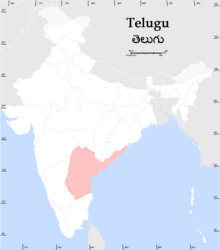ტელუგუ ენა
| ტელეგუ తెలుగు | |
| გავრცელებულია | ინდოეთი |
| მოლაპარაკეთა რაოდენობა | 66 მლნ. მშობლიური, 88 მლნ. სულ |
| ოფიციალური სტატუსი | ოფიციალური სტატუსი ინდოეთში |
| ლინგვისტური კლასიფიკაცია | დრავიდული ოჯახი:
|
| დამწერლობის სისტემა | ტელეგუს დამწერლობა |
| ენის კოდები | SO 639-1: te ISO 639-2: tel ISO/FDIS 639-3: tel |

ტელუგუ, იგივე ანდჰრა — ტელუგუს ენა, მიეკუთვნება დრავიდულ ენებს.
ეტიმოლოგია
[რედაქტირება | წყაროს რედაქტირება]ტელუგუს ეტიმოლოგია არ არის ზუსტად განსაზღვრული, ის, სავარაუდოდ, უნდა მომდინარეობდეს ტრილინგა დესა -დან, რაც „სამი ლინგა ქვეყანას“ ნიშნავს. ინდუისტური ლეგენდის მიხედვით შივამ სამ მთაზე ჩამოუშვა სამი ლინგამი: კალესვარა, სრისაილა და ბიმესვარა რომლებმაც შექმნეს ტელუგუს ქვეყნის საზღვრები.[1]
ზოგადი ცნობები
[რედაქტირება | წყაროს რედაქტირება]უძველესი წერილობითი ძეგლები (რენატი-ჩოდას დინასტიის წარწერები) დათარიღებულია 575-600 წლებით. ლიტერატურული ენა ჩამოყალიბდა IX-XI სს-ში და საკუთარი ნორმები გამოიმუშავა XIV-XVII საუკუნეებში. ტელუგუს ენაზე დიდია სანსკრიტისა და პრაკრიტების ზეგავლენა. იგი იყენებს ტელუგუს ანბანს, რომელიც მომდინარეობს ბრაჰმისაგან.
სტატუსი
[რედაქტირება | წყაროს რედაქტირება]ოფიციალური ენა:
- ინდოეთი - სხვა 15 ენასთან ერთად.
გავრცელების არეალი: ტელუგუ-ენოვანი ხალხი ცხოვრობს აგრეთვე შრი-ლანკაში, სამხრეთ აფრიკის რესპუბლიკაში, მიანმარში, მალაიზიაში, სინგაპურში, მავრიკის და ფიჯის კუნძულებზე.
ლექსიკა
[რედაქტირება | წყაროს რედაქტირება]ფრაზები და სიტყვები
- გამარჯობა - Namaskaaram
- კეთილი იყოს თქვენი მობრძანება - Suswaagatam
- გმადლობთ - Dhanyavaadaalu; Tamara krutagntha
- კი / არა - Avunu
- გეთაყვა - Dayachesi
- ნახვამდის - Selavu; Namaskaaram
რიცხვები
- 1 - okati, 2 - rendu, 3 - mu:du, 4 - na:lugu, 5 - ayidu, 6 - a:ru, 7 - e:du, 8 - enimidi:, 9 - tommidi:, 10 - padi
ლიტერატურა
[რედაქტირება | წყაროს რედაქტირება]- Albert Henry Arden, A Progressive Grammar of the Telugu Language (1873).
- Charles Philip Brown, English–Telugu dictionary (1852; revised ed. 1903; online edition)
- Charles Philip Brown, A Grammar of the Telugu Language (1857)
- P. Percival, Telugu–English dictionary: with the Telugu words printed in the Roman as well as in the Telugu Character (1862, google books edition)
- Gwynn, J. P. L. (John Peter Lucius). A Telugu–English Dictionary Delhi; New York: Oxford University Press (1991; online edition).
- Uwe Gustafsson, An Adiwasi Oriya–Telugu–English dictionary, Central Institute of Indian Languages Dictionary Series, 6. Mysore: Central Institute of Indian Language (1989).
- Vēlcēru Nārāyaṇarāvu, David Dean Shulman, Velcheru Narayana Rao, Classical Telugu Poetry: An Anthology (2002).
- Callā Rādhākr̥ṣṇaśarma, Landmarks in Telugu Literature: A Short Survey of Telugu Literature (1975).
რესურსები ინტერნეტში
[რედაქტირება | წყაროს რედაქტირება] ვიქსიკონში განმარტებულია სიტყვა: ტელუგუ ენა
ვიქსიკონში განმარტებულია სიტყვა: ტელუგუ ენა

- Ethnologue report for Telugu
- Hints and resources for learning Telugu დაარქივებული 2013-10-19 საიტზე Wayback Machine.
- English to Telugu online dictionary
- 'Telugu to English' & 'English to Telugu' Dictionary
სქოლიო
[რედაქტირება | წყაროს რედაქტირება]- ↑ History of Kannada language: readership lectures By R. Narasimhacharya
Text is available under the CC BY-SA 4.0 license; additional terms may apply.
Images, videos and audio are available under their respective licenses.
